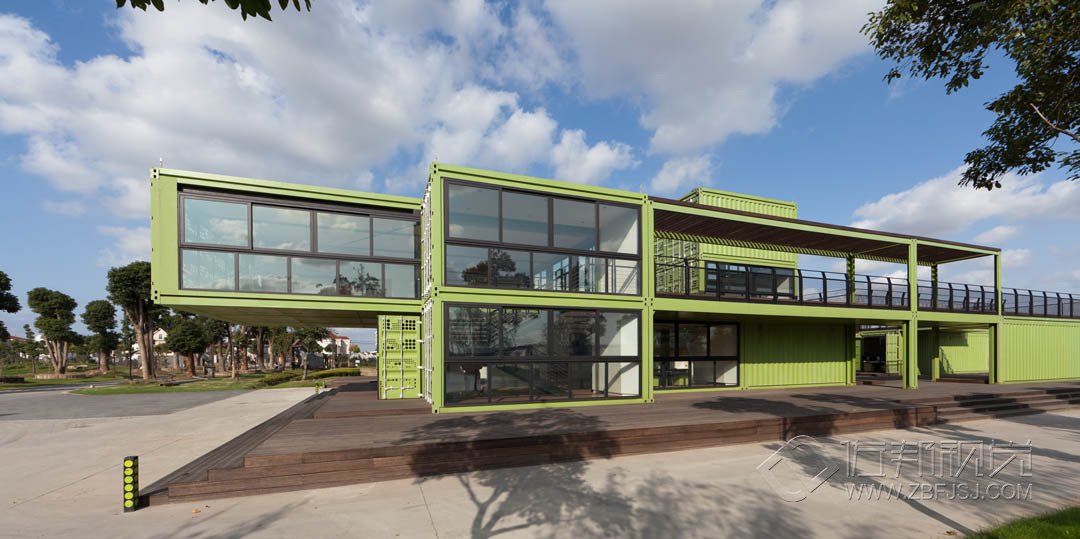上海多利农庄的这栋建筑将接待、门厅、VIP、办公和食品包装等功能整合在一起。建筑采用集装箱建设,集装箱的不规则布置模式适应各种需求并创造丰富空间,设计和建造过程植入的各项环保措施使项目成为了一座真正的具有可持续性的建筑。
多利农庄是上海最大的有机食品农庄,其产品包括国家环保总局检验认证的各种有机蔬菜和水果。在多利农庄的发展蓝图中,成为一个蔬菜生产基地不只是她的全部目标,这里将建设为上海一处引领自然生活方式的新地标。
这座建筑是一个整合了接待区、门厅(未来可为酒店客房服务)、贵宾区、农庄新办公区和食品包装车间的综合体。Playze在设计中将农庄的生产活动和参观者的体验密切地联系在一起。

生产流程处于一个通透环境中,参观者可以仔细观察操作的每一个环节,提升对农庄产品质量的信心。可持续发展方式和对于质量的不懈追求相结合,形成多利农庄的核心精神,这也是设计中始终坚持的核心理念。
空间概念
为了将室内外的不同功能在实际使用上和视觉上建立一定的联系,建筑设计为一个连续的空间序列,当参观者穿行于建筑和场地时,空间序列的发展逻辑不易被察觉,这需要参观者自己去体验并发现。建筑二层的平台系统不只是作为交通空间,还是室内空间的延伸和休闲区。为了满足业主在自然环境中工作的愿望,室外平台可作为户外的会议区,并可灵活实现其他的一些活动。这样,特定空间的使用也可减少。
在项目中,建筑与环境在空间上所要建立的直接联系,是食品生产的工业化特征与周围农庄环境之间的虚拟对话。通过创造不同类型的视觉连接,设计的总体策略得以实现。
集装箱具有标准化的特征,这与对不同空间的适应度要求相背离,比如入口、庭院、办公、室外平台等都需要不同的空间处理方式。景观方向、功能要求和空间序列,建筑在这三个因素的界定下呈现了不同的空间状态。即使这样,空间框架仍然采用了具有标准尺寸的集装箱。
集装箱的摆放方式总体上遵循了使用空间和气候条件的需要。悬挑部分醒目地提示了场地的主入口,参观者由此进入建筑内部到达接待台。一个由三层集装箱垒起的大堂构成了建筑的核心空间,穿过大堂,参观者就来到了内院,在这里等待的电瓶车可将他们带到酒店客房,或农庄的各个角落。
建筑的第二层通过两座天桥与办公区相连,这部分建筑被保留的厂房建筑覆盖着。厂房的东立面已经移除,所以新增加的集装箱办公室位于现有厂房屋面的下方,并在面对生产区的位置形成了新的内立面。
结构
由于气候条件的影响,建筑需满足防渗、防漏、保温、隔热等各项要求,为了保证集装箱的纯净外表,设计中发展了大量的特殊节点。这些精巧的节点与相对粗犷的集装箱构件形成了鲜明的对照,比如在室内可看到的集装箱框架组合梁。此外,由于集装箱不规则的布置方式,其模数化的系统甚至受到了一定的挑战。
集装箱的结构逻辑是一个框架盒子,其六个方向上的面都可以打开或保持封闭。针对不同的空间形态,这个特征被灵活应用,并最终整合在一个完整的结构体系中。在入口部分,辅助的支撑结构被优化到最小尺寸,以突显集装箱“悬浮”的状态。为了消减盒子的封闭感,三层高的垂直空间分别向三个方向打开。在内院部分,二层的平台即成为下方开敞空间的屋顶,并在设计中引入了一些类似连廊的中式庭院形态。
可持续性
为了实现业主对于环境保护的强烈愿望,项目中采用了一些针对性的策略以减少建筑能耗。整个建筑体都采取了保温隔热措施,即使这样,集装箱仍呈现了它初始的状态。集装箱的门扇在打孔之后安装于朝阳的立面,作为建筑外遮阳减少太阳辐射热,有一台地源热泵设备为空调和地暖提供能量。可控的排风系统帮助优化空气交换的比率,减少能量的损失,LED光源设备的广泛应用也减少了电量消耗。
项目的另一个目标是减少隐藏在建筑材料中的能耗,所谓的“灰色”能量。所以可回收的、生态可持续的、速生的或可循环再利用的材料得到广泛应用。货运集装箱被合理使用,首先因其结构能独立支撑,其次也隐喻“可再利用的空间”。尤其是轻量化的集装箱结构使对原有基础承台的再利用成为可能。速生的本地材料竹子被应用到室内和室外的地坪,以及固定家具。以上所列举的措施使项目成为了一座真正的具有可持续性的建筑。










Tony’s Farm is the biggest organic food farm in Shanghai, which produces OFDC
certified (member of IFOAM) vegetables and fruits. But Tony's Farm is meant to be
more than just a place for vegetable production. The vision is to integrate the consumer
and therefore promote a natural lifestyle.
To link the activities of the working people with the visitors of the farm, playze
developed a building complex, which combines the main reception, a lobby, (working
also for the future hotel rooms) and a vip area, with the new offices and an existing
warehouse, where the fruits and vegetables are being packed. The building provides
transparency within the manufacturing process. Thus it supports the vision of integrating
the visitor and helps to reinforce the consumer confidence in the products of the farm.
At the same time the building design is driven by the concept of sustainability,
combined with it's iconic qualities, it communicates and promotes the core concept of
Tony's Farm.
Spatial concept
The building has been designed as a continuous spatial sequence in order to physically
and visually connect various interior and exterior programs. The whole structure
demands an exploration by the visitors. It is not obvious, how the spatial sequence will
develop, while crossing the building and the site. A system of terraces functions not only
as transitory space but also as extension of the interior work and leisure areas. Outdoor
meetings and other activities support the aspiration of the client to literally work
surrounded by nature and same time reduce the use of conditioned space.
Throughout the project the immediate spatial relationship between the building and the
environment is meant to create a virtual dialogue between the industrial aspects of food
production and the surrounding farmland. The massing strategy supports this ambiguity
by creating various types of visual relations.
The systemic nature of the containers is countered with the adaptation to the specific
situations, like entrance, courtyard, office wing, terraces, etc. The different orientations
towards the landscape of the farm, the functional requirements and the spatial
sequence are defining each situation of the layout in a specific way, although the spatial
framework is the container with its standardized dimensions.
The cubing of the containers follows spatial and climatic demands. The cantilevering
gesture marks the main entrance of the site. This is where the visitors enter the
structure and find the reception desk. After the lobby, which is accentuated by a 3
stories high volume, they step out to an inner courtyard, where they are picked up by
electric cars to be brought to their hotel rooms, distributed throughout the farm.
The second level allows a connection to the office wing of the building via 2 bridges.
This part of the building complex is covered by the existing warehouse. The east
facade has been sliced, so that the new container offices could find shelter underneath
the existing roof and form an new inner facade towards the production hall.
Construction
Since the climatic exigence asked for impermeability and insulation, numerous specific
details had to be developed to maintain the stringent appearance of the containers.
The elaborate details, for example the still visible steel beams of the containers in the
interior, stand in contrast to the rather rough and crude tectonic details of the freight
container. Further, the modular system was challenged by the individual joints, resulting
from the irregular distribution of the containers.
The structural logic of the container is the framed box, which can be opened or left
closed towards the 6 orientations. These characteristics were amplified in different
spatial situations, integrated within the whole structure. At the entrance situation for
instance, the additional supporting structure is reduced to a minimum to underline the
„floating“ moment of the containers. The 3 stories high vertical space is opened to 3
sides to dissolve the box. In the courtyard, the terraces form a roof to the underneath
and quote the chinese courtyard typology, whereas the office part is developed in the
style of a slab and pillar constellation.
Sustainability
In order to cope with the high aspirations of the client regarding the protection of the
environment, several strategies have been used to reduce the energy consumption of
the building. The entire structure is well insulated, even though the containers appear in
it's raw form. The original container doors have been perforated and serve as external
shading blinds at the sun exposed facades to minimize solar heat gain. A geothermal
heat pump delivers energy for the air conditioning and floor heating systems. Controlled
ventilation helps to optimize air exchange rates and therefore to minimize the energy
loss through uncontrolled aeration. The use of LED lighting reduces the general
electricity consumption.
Another ambition of the project is to reduce the energy hidden in construction materials,
the so called grey energy. Therefore recycled, ecologically sustainable, fast growing or
at least recyclable materials have been used. The re-use of freight containers seemed
adequate, first for its inherent structural autarky and second for being a common
metaphor for „recycled space“. Further, the minimal weight of the container structure
allowed to re-use the existing foundation plate. The use of local bamboo products for
indoor and outdoor flooring, as well as all the built-in furniture additionally supports the
ambition of constructing a truly sustainable building.
Project data
Client _ Tony’s Farm
Location _ Shanghai, China
Completed in_ July 2011
Built area _ 1060m2
Number of containers _ 78
Team _ Mengjia He, Pascal Berger, Marc Schmit,
Meijun wu, Liv Xu Ye, Ahmed Hosny, Andres Tovar,
Maggie Tang, Sebastian Hefti
Photo credits _ Bartosz Kolonko